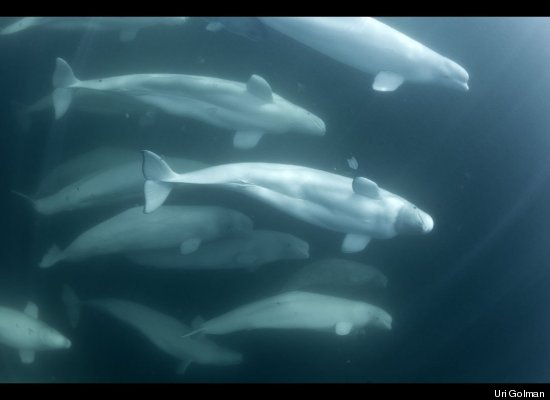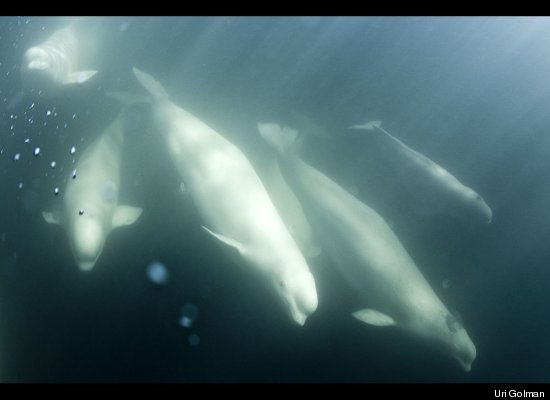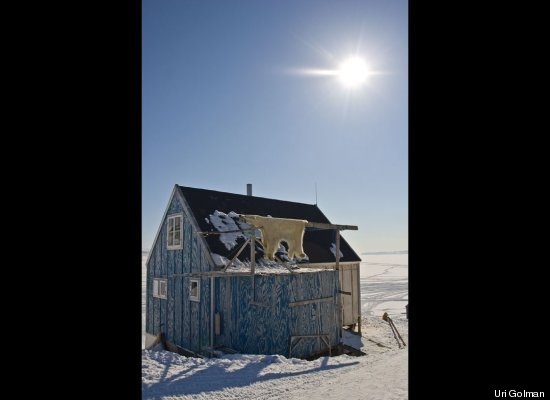VIA – HUFFINGTON POST
Beluga Whales’ Beauty Captured By Photographer Uri Golman In Arctic Encounter (PHOTOS)
First Posted: 10/8/11 02:37 PM ET Updated: 10/8/11 02:37 PM ET
From Uri Golman:
Since I was a child I have always been preoccupied with everything wild. I used to sit in school and daydream for hours about future adventures in the north and about the wildlife that I would see. But nothing had prepared me for the first meeting with the Beluga Whales.
The weather was grey, as we set out from the small cay at Churchill harbor. A few rays of sun came through and a cold wind was blowing from the North. I didn’t really have time to see the beauty as I was going through a final check of my underwater camera gear. As I got into the water I could feel the 2°C cold water entering the 14mm wetsuit but I knew I just had to wait it out. The water was filled with algae that was in full bloom and the visibility was low. Within a short time white shadows emerged out of nowhere and the water was filled with chirping sounds, much like you would hear in a park in springtime. Then things became quiet and suddenly without me having noticed anything a small pod of 4-5 meter long white Beluga Whales came scurrying past. The sounds came back and the water was filled with the bird chirps as a pod of maybe 50-100 whales made their way past me. I was mesmerized. Some of the whales came really close, within touching distance, and turned over to get a better look. I mean I would have been happy just to see one of them up close but that many and at that close a distance was beyond belief. [Text continues after images.]

All photos and captions courtesy of Uri Golman.
Unlike most other whales, its vertebrae is not fused at the neck and therefore the Beluga is able to turn and incline its neck.

In Churchill River, the Beluga whales are often very inquisitive and will come right up to a diver or boat to investigate. In areas where the whales are hunted they are a lot shyer and will shun divers and boats as soon as they approach.

Most things are used from any animal that is killed. Here a skin from a polar bear is hung to dry before being sold locally in Greenland. This skin can be used for making warm pants for hunting in subzero temperatures.
Unfortunately the whales I saw make up a very large part of the entire Beluga whale population. Due to many factors like pollution and over hunting these whales have moved from vulnerable to near threatened on the IUCN Red List and things are not looking bright. Beluga whales are at the top of the food chain and their blubber and internal organs carry high amounts of Persistent Organic Pollutants or POPs as they are called. Especially PCB and DDT are found in high concentrations in Belugas together with large concentrations of heavy metals. All of these pollutants possess a severe risk for anybody eating Beluga and levels of up to 800ppm of PCB has been measured in the blubber of the Belugas of Canada’s St. Lawrence River where some whale populations are considered to be so toxic that they are treated as toxic waste.
For the full article and all the amazing photos go here:
http://www.huffingtonpost.com/2011/10/08/beluga-whales-arctic-conservation_n_998293.html#s393734
 Become A Sponsor!
Become A Sponsor!If you have a product or service that is a good fit for our surf community, we have opportunities for you to sponsor this blog! Download our media kit now!
